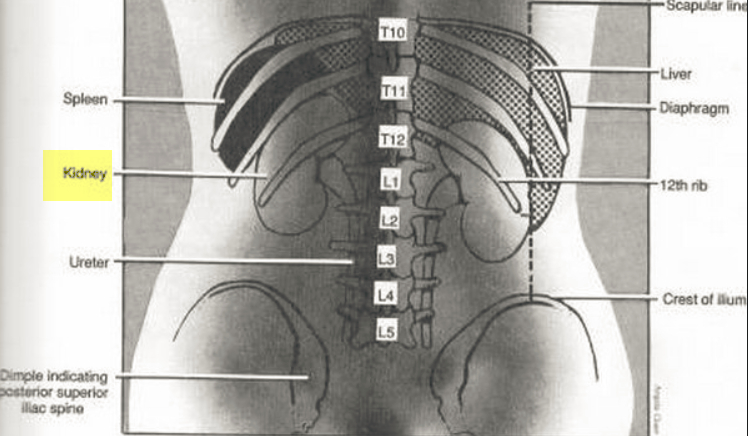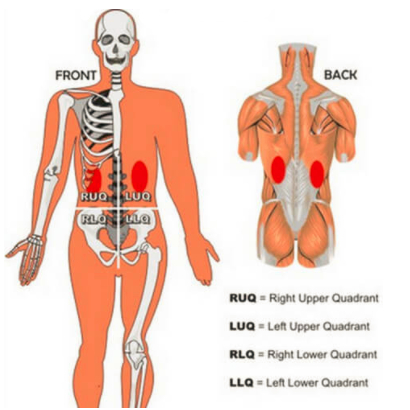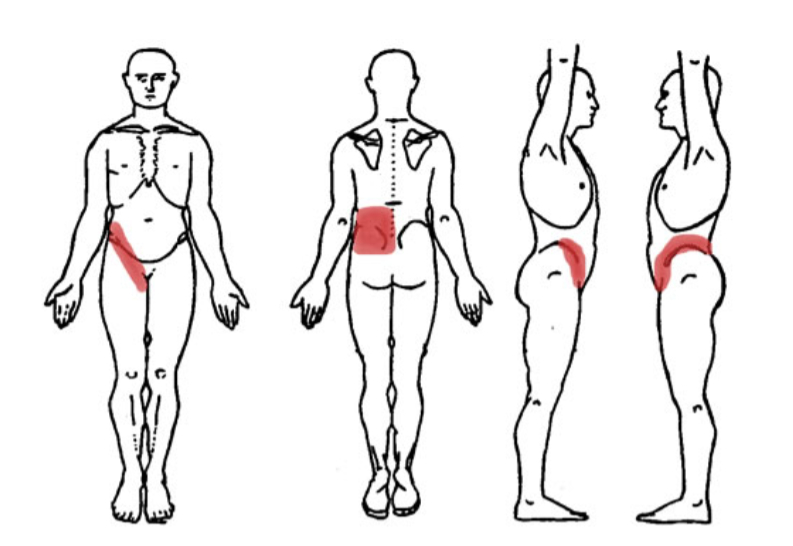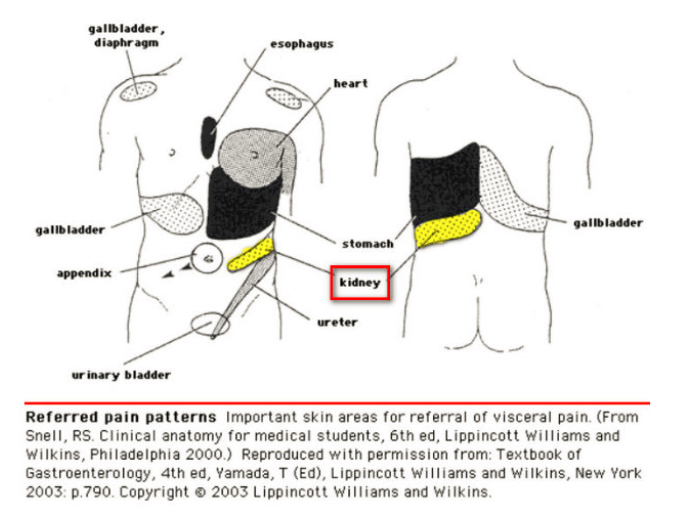The term ‘Kidney Pain’ or ‘Renal pain’ is used randomly whenever a flank pain is felt. This necessarily need not be a pain from the kidney. A variety of causes can always be confused with kidney pain.
Consequently, to differentiate the cause of the pain, it is pertinent to understand where kidney exactly is placed in the body.

Image1 & 2: Kidney pain is felt in the flanks. [3, 4]
Kidney Location (Anatomy)
The kidneys are located in the abdomen (below the diaphragm), nearer to the back side. They are bean shaped organs. Most of it is protected by the back end of the ribs. The right kidney is pushed down slightly by the right lobe of liver. To know about the liver position in the body, kindly refer to ‘Liver Location’.
Surrounding the kidneys there is a layer of fat which further helps in protecting it from blunt injuries.



Image 3 (a,b,c) : The kidneys when seen from behind (back)(surface anatomy) . It can also be noted that its position is corresponding to T12 (Thoracic) vertebra to L3 (Lumbar) vertebra. [5]

Image 4 & 5: From the above image, it is clearly visible that kidneys are placed more towards the back of the body in both male and female. The tubes which connect the Kidneys to the bladder are called as ‘Ureters’ and that which passes the urine from the bladder to the outside is called a ‘Urethra’. [6]

Kidney location in relation to four quadrants of abdomen
Functions of the Kidneys
- Helps in regulating the fluid volume inside the body.
- Helps in regulating the acid base balance inside the body.
- Removes the toxins, drugs and waste products from the blood.
- Helps in regulating the electrolyte balance in the body.
- Produces hormones and neuro-transmitters.[13]
Kidney Pain Location
Where is Kidney Pain felt?

Image 6: The colored areas in the image are the region in which renal pain/ kidney pain/ flank pain occurs. [7]
 Referred pain pattern in kidney pain and its areas in yellow color
Referred pain pattern in kidney pain and its areas in yellow color
What does kidney pain feel like?
Generally the pain from kidneys is felt as dull aching pain[2]. Occasionally when there is a sudden obstruction of the ureters due to a stone, the ureters try to push it downward by its own movement. This may cause a sharp pain (renal colic) [1].
What causes Kidney pain/ flank pain?
The pain which is referred to as kidney pain may sometimes not be from kidneys at all.
What are the possible conditions causing similar pain? Differential diagnosis
| Condition | Site of Pain | Clinical findings |
| Appendicitis | Near to the umbilicus and radiates to the right lower quadrant of the abdomen. |
|
| Acute urinary retention | Lower abdomen |
|
| Cystitis | Lower abdomen |
|
| Diverticulitis | Left or Right lower quadrant of the abdomen |
|
| Endometriosis | Left or right lower quadrant of the abdomen |
|
| Infectious colitis | Right or left lower quadrant of the abdomen. But may present as whole abdomen pain. |
|
| Lower back pain | Pain in the lower back |
|
| Nephrolithiasis | Pain maybe in the flanks, lower abdomen or back |
|
| Pyelonephritis | Flanks, lower abdomen or back |
|
Table: Differential diagnosis for flank pain. The above given are conditions that may resemble kidney pain. [8, 9, 10, 11, 12]
So What Causes Pain in Your Kidneys?
Pain in the kidneys can be due to any obstruction in the urinary tract (Kidneys, ureters, Bladder, urethra), disease of the urinary tract, congenital abnormalities or malignancies. [2, 14, 15, 16]
| Condition | Site of pain | Clinical findings |
| Polycystic Kidney disease- Multiple cysts in the kidneys [17] | Back pain or abdominal pain |
|
| Hydronephrosis- Swelling of the kidney | Upper back or flanks |
|
| Pyelonephritis- Infection of the kidney [20] | Flanks (Left, right or both) |
|
| Rupture of cyst in kidney [19] | Flanks |
|
| Kidney tumours [19] | Flanks and Upper back |
|
| Stones in kidney, ureter or bladder [21, 22] | Upper back, flanks, lower abdomen |
|
| Urinary tract infection | Lower abdomen |
|
| Glomerulonephritis [23] | Flanks and Upper back |
|
| Renal vein thrombosis [24, 25] | Lower back and sides of abdomen |
|
Symptoms & Signs of Kidney disease
The symptoms and signs mentioned below are usually found with kidney or urinary tract diseases. It is important to get a medical attention to diagnose the exact cause for appropriate management of the condition[2].
- Fever
- Pain
- Dysuria- Painful urination.
- Haematuria- blood in the urine
- Frequency- Increased frequency of passing urine
- Urgency- Compelling urge to urinate
- Nausea
- Vomiting
- Anorexia
- Chills
- Edema – Swelling in the ankles. Sometimes there can be generalized oedema which occurs throughout the body.
How is Kidney Pain diagnosed?
Diagnosis over kidney pain involves a proper history evaluation and examination by the doctor. In most conditions, the doctor will have an initial suspicion regarding the cause of the pain. This will further be confirmed or excluded by appropriate investigations which will be advised. The usual investigations involved in diagnosis of kidney pain include the following. [2]
- Complete blood count
- Urine routine examination
- Urine culture and blood culture
- Kidney function tests- Blood urea, serum creatinine, blood urea and nitrogen
- Pregnancy test
- Ultrasonography of the abdomen and KUB region
- Abdomen- CT/ MRI
Treatment
The treatment of kidney pain depends on the cause of the pain itself. If it is a stone, the stone has to be removed. If it is an infection, then antibiotics needs to be given. Symptomatic treatments are also provided such as pain killers and antipyretics. Certain conditions like malignancy would require extensive surgeries to be done. [2]
General measures
- In kidney stones, avoid chickpeas, cauliflower, carrots, turnips and increase intake of watermelons, grapes, Cranberry juice, grapefruits etc[26].
- Avoid alcohol which can aggravate the pain.
- Drink more water daily.
- Plenty of rest.
References:
- Dave, C., MD. “Nephrolithiasis.” Medscape. Updated: Aug 07, 2016. http://emedicine.medscape.com/article/437096-overview
- https://www.medicinenet.com/kidney_pain/article.htm
- Image 1: https://www.reference.com/science/kidney-located-db85177cfeb39f1d
- Image 2: http://hillclinic.com/en/laser-treatment-nephrolithiasis/
- Image 3: http://philschatz.com/anatomy-book/contents/m46429.html
- Image 4 & 5: https://www.news-medical.net/health/What-is-the-Urethra.aspx
- Image 6: http://www.lower-back-pain-toolkit.com/back-pain-kidney.html
- https://www.uptodate.com/contents/image?imageKey=PC%2F106202&source=contentShare&csi=eb1607cf-c744-4cfa-96c5-86cb87fd8fe7
- https://emedicine.medscape.com/article/1958746-overview#showall
- https://en.wikipedia.org/wiki/Endometriosis
- https://www.mayoclinic.org/diseases-conditions/endometriosis/symptoms-causes/syc-20354656
- https://www.emedicinehealth.com/colitis/page2_em.htm
- https://www.livescience.com/52047-kidneys.html
- http://www.kidneyfund.org/kidney-disease/kidney-problems/kidney-pain.html
- http://www.uptodate.com/home. Accessed Jan. 14, 2017.
- https://www.mayoclinic.org/symptoms/kidney-pain/basics/causes/sym-20050902
- Diagnosis and management of chronic kidney disease; Scottish Intercollegiate Guidelines Network – SIGN (June 2008)
- https://www.nhs.uk/Conditions/Hydronephrosis/Pages/Introduction.aspx
- https://www.mayoclinic.org/diseases-conditions/kidney-cancer/symptoms-causes/syc-20352664
- https://emedicine.medscape.com/article/245559-clinical#showall
- http://www.uptodate.com/contents/kidney-stones-in-adults-beyond-the-basics
- https://emedicine.medscape.com/article/437096-clinical#showall
- https://emedicine.medscape.com/article/239278-clinical
- http://www.healthcommunities.com/nephrotic-syndrome-ns/what-is-renal-vein-thrombosis.shtml
- http://www.healthofchildren.com/R/Renal-Vein-Thrombosis.html
- https://www.ihealthblogger.com/kidney-pain-location-symptoms-causes-diagnosis-treatment/

